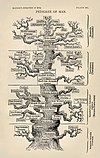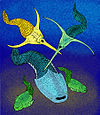IntroductionSelected article on the Silurian world and its legacies The Archaea show many differences in their biochemistry from other forms of life, and so they are now classified as a separate domain in the three-domain system. So far, the Archaea have been further divided into four recognized phyla. Classification is still difficult, because the vast majority have never been studied in the laboratory. Archaea and bacteria are quite similar in size and shape, but despite this visual similarity to bacteria, archaea possess genes and several metabolic pathways that are more closely related to those of eukaryotes. Other aspects of archaean biochemistry are unique, such as their reliance on ether lipids in their cell membranes. Archaea use a much greater variety of sources of energy than eukaryotes: ranging from familiar organic compounds such as sugars, to ammonia, metal ions or even hydrogen gas. Salt-tolerant archaea use sunlight as an energy source, and other species of archaea fix carbon. Archaea reproduce asexually by binary fission, fragmentation, or budding. Archaea are found in a broad range of habitats, includingsoils, oceans, marshlands and the human colon and navel. Archaea are now recognized as a major part of Earth's life and may play roles in both the carbon cycle and the nitrogen cycle. (see more...) Selected article on the Silurian in human science, culture and economics In 1858, Charles Darwin and Alfred Russel Wallace published a new evolutionary theory that was explained in detail in Darwin's On the Origin of Species (1859). Unlike Lamarck, Darwin proposedcommon descent and a branching tree of life. The theory was based on the idea of natural selection, and it synthesized a broad range of evidence from animal husbandry, biogeography, geology, morphology, and embryology. The debate over Darwin's work led to the rapid acceptance of the general concept of evolution, but the specific mechanism he proposed, natural selection, was not widely accepted until it was revived by developments in biology that occurred during the 1920s through the 1940s. Before that time most biologists argued that other factors were responsible for evolution. The synthesis of natural selection with Mendelian genetics during the 1920s and 1930s founded the new discipline of population genetics. Throughout the 1930s and 1940s, population genetics became integrated with other biological fields, resulting in a widely applicable theory of evolution that encompassed much of biology—the modern evolutionary synthesis. (see more...) Selected image
Did you know?
Need help?Do you have a question about Abyssal/Portal:Silurian that you can't find the answer to? Consider asking it at the Wikipedia reference desk. GeochronologyEpochs - Llandovery - Wenlock - Ludlow - Pridoli Plants - Lycopods - Rhyniophytes - Vascular plants Fossil sites - Yea Flora Fossil Site Researchers - Increase A. Lapham - Roderick Murchison Quality ContentFeatured Silurian articles - Fungus SubcategoriesRelated contentAssociated WikimediaThe following Wikimedia Foundation sister projects provide more on this subject:
|



















